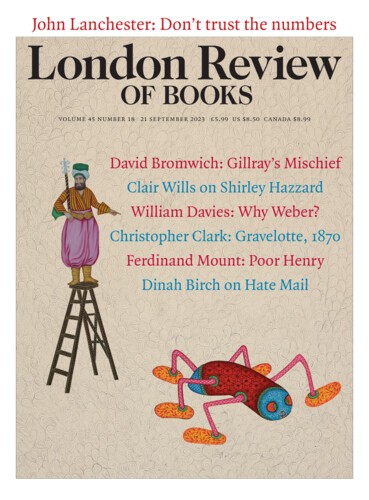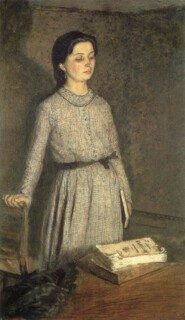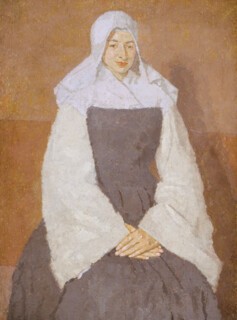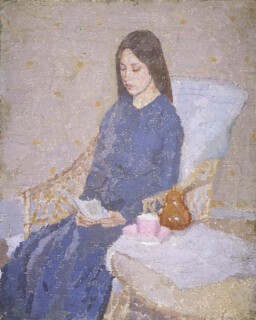In October 2012, Pallant House Gallery in Chichester put on an exhibition of works by the painters Gwen John and Celia Paul. What now seems obvious was then inspired. The comparison diminished neither. Two artists, distinct but in obvious affinity, spoke across their different periods and each made the other more necessary, more triumphant. It was as though Cézanne and Van Gogh had lived a century apart, the fingers of one stretching out almost to touch the other.
John, who was born in Wales in 1876 and died in Dieppe in 1939, has always been admired, and greatly admired by some, but not as widely admired as she deserves. There are reasons for this. She spent most of her life in France, and her work might be seen to make more sense in a French context. She had a famous younger brother, Augustus John, and a famous older lover, Auguste Rodin. Her pictures are, on the whole, characterised by restraint of tone and technique. There are not very many of them. She lived quietly. She was a Catholic. She was a woman.
Her letters, and surviving accounts of her character, point to something more dynamic. In Letters to Gwen John (2022), Paul quotes Augustus’s description of his sister: ‘She didn’t steal through life but preserved a haughty independence which people mistook for humility.’ In an early self-portrait, now held at the National Portrait Gallery, she stands, hand on hip, appraising the viewer. Her gaze is firm and her face, which is interesting and not exactly plain, offers us something like a challenge. John sets her reddish hair against a dark reddish background, and a black shawl covers one forearm, meeting the black belt that echoes the black bow around her neck. The middle of the picture is taken up with her billowing red blouse, which exceeds the canvas. Perhaps she learned from Rembrandt’s early portraits, or from Titian, how a posture becomes a declaration, a costume a character.
This painting is crucially missing from the current exhibition at Pallant House, which considers John alongside her contemporaries and antecedents (until 8 October). It seems astonishing that Edwin John, a well-heeled Welsh lawyer, allowed his daughter to study at the Slade, then perhaps the most progressive British art institution, and to live independently alongside other students in London. The pair had at least one serious falling out. In the 1890s, when both Gwen and Augustus were students there, the Slade took more women than men, though they were taught separately. A selection of life drawings at Pallant House show how talented these students were, not only John but also Ida Nettleship and Elinor Monsell.
It seems no less astonishing that after finishing at the Slade, John set out to walk to Rome with her friend Dorelia McNeill, catching a steamer to Bordeaux then tracing the Garonne river, sleeping outdoors and making portrait sketches for food or cash. John’s portrait of Dorelia – ‘Dodo’ – in red chalk suggests something of the aloof, seductive quality that attracted both siblings to her, but this Dorelia keeps her own counsel. Augustus’s portrait of Dorelia from the same year, 1903, which hangs in the same room at Pallant House, is a hideous thing, and though it arrives at the start of the show seems the last word on Augustus. He will play a minor role in John’s art after this.
In the end, the two friends travelled only as far as Toulouse, where they spent the winter and John painted Dorelia’s portrait at least twice. The second of these, given the name L’Étudiante, shows Dorelia standing by a desk, leaning against the chair, looking down at her books. She carries another, smaller book in her hand. There is no window, but the strong glow from the lower right-hand side tells us it is evening. There is a lamp or candle just out of sight; it lights Dorelia’s slightly flushed face and casts a large shadow on the wall behind her. Again, John pays attention to posture and costume – the black shawl on the table, the black ribbon around the waist.
But Dorelia doesn’t fill the canvas and she doesn’t look out at the viewer. Her expression is contemplative, though there is torque in the angle of her hips and pressure on the hand holding the chair. The room is very plain, the chair too small, and the sitter herself is quite unaware of us. The paintwork is scratchy in places, dabbed and daubed in others, and the tones are calibrated through cool blues and yellow browns. One of John’s friends at the Slade said she kept a ‘clean and orderly palette’, even before she attended Whistler’s Académie Carmen in Paris. Whistler liked to say that ‘the picture was practically finished on the palette’, and would prove so in bravura demonstrations to his students. Taking up paints and palette, he would decide on the ‘general tone of the model’, according to his assistant, Cyril Cuneo, then mix
with the knife a lump of paint to represent this tone [and] drag in similar colours, light and dark, to form the transitional tones from light to shadow … the palette was now a true harmony in every sense; in itself it would have almost served as a picture.
Whistler’s paintings are more self-consciously fin de siècle than John’s, and Vuillard, who is often invoked in comparison, was also decorative in ways John was not (in his case, this manifests as a constant busyness). One of the advantages of seeing a number of her works together is that the viewer can begin to appreciate the studied effacement of her canvases, which the Pallant House show puts down to the influence of Cézanne, but was surely more intuitive and experimental. It is seen to best effect in her paintings from the late 1910s and early 1920s, the ‘convalescent’ series and the portraits of nuns.
Between these two periods – the early 1900s and the mid-1910s – are life studies, portraits of friends, nudes, nearly all of them women. John often visited the Louvre and took ideas from things she saw there, giving a girl the face of a Dürer, taking the Annunciation as the model for a new sort of picture: a young woman in a room of her own, reading a book near an open window. Through Rodin, John got to know Rilke, and Alicia Foster, who curated the current exhibition, makes a convincing link with Rilke’s poem ‘Verkündigung’, where the angel, invisible to Mary, is like ‘a breeze within the wood’: ‘But still you keep your solitude/And hardly notice me.’ The better of two paintings from 1911 that show a woman reading by a window – full of light but with the rich darkness of dress that John preferred in her early works – is at MoMA in New York and didn’t travel for the exhibition. It gestures to a path not taken, of domestic scenes not quite modern but fresh and idiosyncratic, in which the figure (and perhaps there would have been more than one figure) is intriguing, animated – unlike in Hammershøi’s paintings – but unavailable. The word John liked was recueillie, ‘collected’.
John painted less during her years with Rodin. She wanted, as Paul puts it, ‘to give herself up entirely to the experience’. She was both model and lover, but never the only woman to occupy either role, and though the exhibition doesn’t dwell on this period, it makes for unhappy reading in John’s letters. At times she became quite desperate, as she did during a later infatuation with a neighbour, Véra Oumançoff, and it was these affairs that caused Augustus to say, perhaps unkindly, that his sister’s passions ‘for both men and women were outrageous and irrational’. Rodin pulled away from her, suggesting other sculptors for whom she might model, and blaming his lack of ardour on headaches. John also had headaches, from his not visiting her, and in a note of 1911 instructs herself to ‘Pray to God incessantly’ and ‘Controle your emotions. They are infidelities to God.’
Her religious turn and formal conversion to Catholicism, in 1913, coincided with the crisis in her relationship with Rodin and her move to Meudon, where he lived. Not long after her acceptance into the Church, she was commissioned by the nuns at the local convent to paint a portrait of their founder, Mère Poussepin. John worked from an earlier, inferior painting reproduced on a prayer card and made six paintings of contained vitality. She went on to paint other nuns at the convent in the same 17th-century dress, which she made up from cloth she bought in Paris: a dull blue dress (or apron) with great soft white sleeves and a Dutch cap in still brighter white. The pictures themselves are not large or flamboyant, and some are almost austere. But they seem to vibrate. There are suggestions of movement in the cloth, in the stippling of paint (which sometimes looks like wear or decay) and the shakiness of brushstrokes. Shadows swim. And more than this, the sitters catch us with their mocking half-smiles, their hauteur, their impassive stares. They are most un-nunlike.
This quality of animated stillness is present, if not so palpable, in the paintings of a favoured, though unidentified, model in a blue dress, who sits reading in the series John referred to as her ‘convalescent’ pictures, and in the portraits done in pinks and reds, some of them left perhaps deliberately unfinished. John did not exhibit very often as she grew older, but her paintings sold well and she had an American patron, John Quinn, whom she sometimes derided in her letters but who appears to have been far-sighted and ardent in his appreciation. One of her Mère Poussepins was sent to him and she visited his dealer in Paris to see the other works going out with it: ‘I went with Mrs Foster to see the pictures you have bought at Pottier’s. I was very pleased and proud of my Mère Poussepin. I thought it the best picture there but I liked the Seurat landscapes.’ An exhibition in 2008 brought together many of the Meudon nun portraits, and Pallant House has hung its three rather cleverly in false archways, but it would be something to see them all together – and it is something of a surprise to learn that one of the Mère Poussepins sold at Sotheby’s last year for less than £120,000.
The exhibition loses its way a little at the end. John didn’t paint much in the final period of her life, though she died aged just 67. It would be interesting to know why. Religion seemed not to dissipate the fervour she had for painting but to concentrate it. She brushed off the curé who suggested she should stop drawing and painting during mass – ‘my spirit is not able to pray for a long time at a stretch [and] the orphans with those little black hats with white ribbons and their black dresses with little white collars charm me.’ Other odd decisions are distracting: why overshadow the works in the first room with a large reproduction of John modelling in the nude, her face blurred? Her sensuality and self-discipline are better attested to in her letters and pictures; her appearance in her self-portraits. Why tell us again and again that her work was compared positively to Picasso, or call Rodin’s drawings ‘astonishing’ in one place and dismiss them in another? Foster’s new biography, which stands in as a catalogue for the show, does a better job of proving John’s worldliness.* And the pictures speak for themselves.
Send Letters To:
The Editor
London Review of Books,
28 Little Russell Street
London, WC1A 2HN
letters@lrb.co.uk
Please include name, address, and a telephone number.




